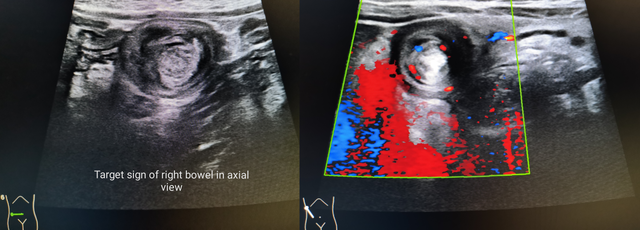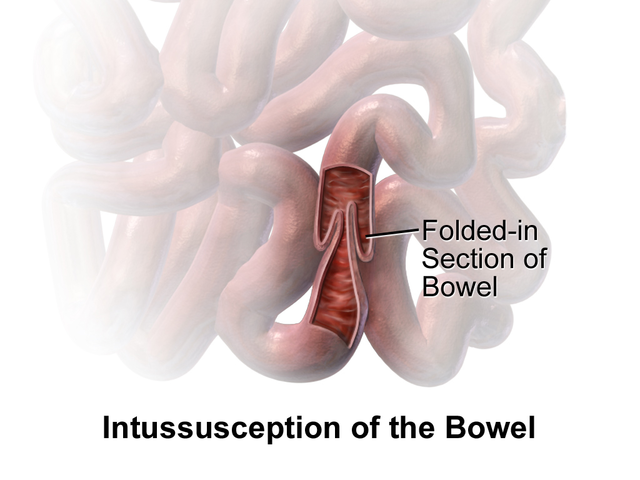[1]
McRae JE, Quinn HE, Saravanos GL, McMinn A, Britton PN, Wood N, Marshall H, Macartney K. Paediatric Active Enhanced Disease Surveillance (PAEDS) annual report 2016: Prospective hospital-based surveillance for serious paediatric conditions. Communicable diseases intelligence (2018). 2019 Feb 1:43():. doi: 10.33321/cdi.2019.43.5. Epub 2019 Feb 1
[PubMed PMID: 30727704]
[2]
Jia Y, Fu H, Li N, Kang Q, Sheng J. [Diagnosis and treatment for 46 cases of Peutz-Jeghers syndrome]. Zhong nan da xue xue bao. Yi xue ban = Journal of Central South University. Medical sciences. 2018 Dec 28:43(12):1323-1327. doi: 10.11817/j.issn.1672-7347.2018.12.007. Epub
[PubMed PMID: 30643048]
Level 3 (low-level) evidence
[4]
Restivo V, Costantino C, Giorgianni G, Cuccia M, Tramuto F, Corsello G, Casuccio A, Vitale F. Case-control study on intestinal intussusception: implications for anti-rotavirus vaccination. Expert review of vaccines. 2018 Dec:17(12):1135-1141. doi: 10.1080/14760584.2018.1546122. Epub 2018 Nov 19
[PubMed PMID: 30407079]
Level 2 (mid-level) evidence
[5]
Teixeira H, Hauswirth F, Römer N, Muller MK, Baechtold M. An ileo-colic intussusception reaching down to the descending colon - A case report. International journal of surgery case reports. 2022 Apr:93():107009. doi: 10.1016/j.ijscr.2022.107009. Epub 2022 Apr 2
[PubMed PMID: 35381552]
Level 3 (low-level) evidence
[6]
Patsikas MN, Papazoglou LG, Paraskevas GK. Current Views in the Diagnosis and Treatment of Intestinal Intussusception. Topics in companion animal medicine. 2019 Dec:37():100360. doi: 10.1016/j.tcam.2019.100360. Epub 2019 Sep 11
[PubMed PMID: 31837757]
Level 3 (low-level) evidence
[7]
Zhang B, Wu D, Liu M, Bai J, Chen F, Zhang R, Fang Y. The diagnosis and treatment of retrograde intussusception: a single-centre experience. BMC surgery. 2021 Nov 13:21(1):398. doi: 10.1186/s12893-021-01391-0. Epub 2021 Nov 13
[PubMed PMID: 34774032]
[8]
Minney-Smith CA, Levy A, Hodge M, Jacoby P, Williams SH, Carcione D, Roczo-Farkas S, Kirkwood CD, Smith DW. Intussusception is associated with the detection of adenovirus C, enterovirus B and rotavirus in a rotavirus vaccinated population. Journal of clinical virology : the official publication of the Pan American Society for Clinical Virology. 2014 Dec:61(4):579-84. doi: 10.1016/j.jcv.2014.10.018. Epub 2014 Nov 4
[PubMed PMID: 25464971]
[9]
Bari H, Karkhanis S, Dasari BVM. Pyloroduodenojejunal Intussusception due to Hyperplastic Polyp of the Brunner Gland. Journal of gastrointestinal surgery : official journal of the Society for Surgery of the Alimentary Tract. 2021 Feb:25(2):565-566. doi: 10.1007/s11605-020-04662-y. Epub 2020 Jun 3
[PubMed PMID: 32495134]
[10]
Khalifa AB, Jebali A, Kedher M, Trabelsi A. [Infectious etiology of acute idiopathic intussusception in children]. Annales de biologie clinique. 2013 Jul-Aug:71(4):389-93. doi: 10.1684/abc.2013.0859. Epub
[PubMed PMID: 23906565]
[11]
Pham T, La Paglia D, Pitcher M. Salmonella enteritis: A Rare Cause of Adult Intussusception. Annals of coloproctology. 2017 Oct:33(5):201-203. doi: 10.3393/ac.2017.33.5.201. Epub 2017 Oct 31
[PubMed PMID: 29159169]
[12]
Wu PW, Wang CC. Concurrent Campylobacter jejuni bacteremia and intussusception in an immunocompetent five-year-old child. Journal of microbiology, immunology, and infection = Wei mian yu gan ran za zhi. 2019 Apr:52(2):367-369. doi: 10.1016/j.jmii.2018.09.004. Epub 2018 Sep 24
[PubMed PMID: 30293925]
[13]
Shen G, Liu H, Guan Z, Shang X, Li J, Zhang C, Zhang J, Liu Y, Hu Q. Clinical features and factors leading to early recurrence of intussusception after saline reduction. JPMA. The Journal of the Pakistan Medical Association. 2020 Oct:70(10):1727-1730. doi: 10.5455/JPMA.21744. Epub
[PubMed PMID: 33159742]
[14]
Bogdanović M, Blagojević M, Kuzmanović J, Ječmenica D, Alempijević Đ. Fatal intussusception in infancy: forensic implications. Forensic science, medicine, and pathology. 2019 Jun:15(2):284-287. doi: 10.1007/s12024-018-0039-y. Epub 2018 Nov 5
[PubMed PMID: 30397871]
[15]
Cha PI, Gurland B, Forrester JD. First Reported Case of Intussusception Caused by Escherichia coli O157:H7 in an Adult: Literature Review and Case Report. Surgical infections. 2019 Jan:20(1):95-99. doi: 10.1089/sur.2018.137. Epub 2018 Oct 25
[PubMed PMID: 30359547]
Level 3 (low-level) evidence
[16]
Bodnár D, Kiss ÁL, Réti G. [Modern understanding of intussusception and recent trends in management]. Orvosi hetilap. 2020 Aug:161(32):1331-1338. doi: 10.1556/650.2020.31779. Epub
[PubMed PMID: 32750021]
Level 3 (low-level) evidence
[17]
Cho HK, Hwang SH, Nam HN, Han K, Kim B, Kong I, Park K, Lee J. Incidence of intussusception before and after the introduction of rotavirus vaccine in Korea. PloS one. 2020:15(8):e0238185. doi: 10.1371/journal.pone.0238185. Epub 2020 Aug 28
[PubMed PMID: 32857776]
[18]
Das MK, Arora NK, Mathai J, Sam CJ, G R, R K, K J, Arunachalam P, Gupta B. Profile and Epidemiology of Intussusception in Children Under-Two Years of Age: A Prospective Surveillance. Indian journal of pediatrics. 2021 Dec:88(12):1187-1194. doi: 10.1007/s12098-021-03776-8. Epub 2021 May 31
[PubMed PMID: 34057604]
[19]
Kim PH, Hwang J, Yoon HM, Lee JY, Jung AY, Lee JS, Cho YA. Predictors of failed enema reduction in children with intussusception: a systematic review and meta-analysis. European radiology. 2021 Nov:31(11):8081-8097. doi: 10.1007/s00330-021-07935-5. Epub 2021 May 11
[PubMed PMID: 33974147]
Level 1 (high-level) evidence
[20]
Coca Robinot D, Liébana de Rojas C, Aguirre Pascual E. Abdominal emergencies in pediatrics. Radiologia. 2016 May:58 Suppl 2():80-91. doi: 10.1016/j.rx.2016.02.003. Epub 2016 Mar 31
[PubMed PMID: 27041066]
[21]
Peyvasteh M, Askarpour S, Javaherizadeh H, Beigom Al-Taha B. Intussuception at atypical ages in children and adults--11 years experiences. Polski przeglad chirurgiczny. 2011 Jun:83(6):304-9. doi: 10.2478/v10035-011-0047-z. Epub
[PubMed PMID: 22166546]
[22]
Zhang Y, Zou W, Zhang Y, Ye W, Chen X, Liu Q, Liu H, Si C, Jia H. Reducing Antibiotic Use for Young Children with Intussusception following Successful Air Enema Reduction. PloS one. 2015:10(11):e0142999. doi: 10.1371/journal.pone.0142999. Epub 2015 Nov 16
[PubMed PMID: 26569111]
[23]
Sáez-Llorens X, Velázquez FR, Lopez P, Espinoza F, Linhares AC, Abate H, Nuñez E, Venegas G, Vergara R, Jimenez AL, Rivera M, Aranza C, Richardson V, Macias-Parra M, Palacios GR, Rivera L, Ortega-Barria E, Cervantes Y, Rüttimann R, Rubio P, Acosta CJ, Newbern C, Verstraeten T, Breuer T. A multi-country study of intussusception in children under 2 years of age in Latin America: analysis of prospective surveillance data. BMC gastroenterology. 2013 May 27:13():95. doi: 10.1186/1471-230X-13-95. Epub 2013 May 27
[PubMed PMID: 23710610]
[24]
Davidson A. Anesthetic management of common pediatric emergencies. Current opinion in anaesthesiology. 2013 Jun:26(3):304-9. doi: 10.1097/ACO.0b013e328360ea40. Epub
[PubMed PMID: 23563798]
Level 3 (low-level) evidence
[25]
Rice-Townsend S, Chen C, Barnes JN, Rangel SJ. Variation in practice patterns and resource utilization surrounding management of intussusception at freestanding Children's Hospitals. Journal of pediatric surgery. 2013 Jan:48(1):104-10. doi: 10.1016/j.jpedsurg.2012.10.025. Epub
[PubMed PMID: 23331801]
[26]
Grama F, Onica M, Chitul A, Bezede C, Burcoș T, Cristian D. Appendix intussusception: a challenging differential diagnosis. ANZ journal of surgery. 2020 Oct:90(10):2090-2091. doi: 10.1111/ans.15727. Epub 2020 Jan 25
[PubMed PMID: 31981391]
[27]
Gluckman S, Karpelowsky J, Webster AC, McGee RG. Management for intussusception in children. The Cochrane database of systematic reviews. 2017 Jun 1:6(6):CD006476. doi: 10.1002/14651858.CD006476.pub3. Epub 2017 Jun 1
[PubMed PMID: 28567798]
Level 1 (high-level) evidence
[28]
Yang G, Wang X, Jiang W, Ma J, Zhao J, Liu W. Postoperative intussusceptions in children and infants: a systematic review. Pediatric surgery international. 2013 Dec:29(12):1273-9. doi: 10.1007/s00383-013-3345-1. Epub 2013 Jul 13
[PubMed PMID: 23852556]
Level 1 (high-level) evidence
[29]
Xie X, Wu Y, Wang Q, Zhao Y, Chen G, Xiang B. A randomized trial of pneumatic reduction versus hydrostatic reduction for intussusception in pediatric patients. Journal of pediatric surgery. 2018 Aug:53(8):1464-1468. doi: 10.1016/j.jpedsurg.2017.08.005. Epub 2017 Aug 8
[PubMed PMID: 28827051]
Level 1 (high-level) evidence


